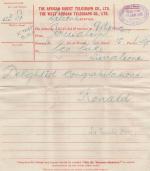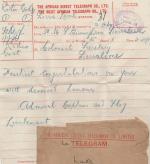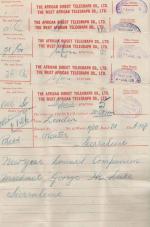Luke, Collection of Manuscript Letters Signed (MLS) / Autographed Letters Signed
Collection of Manuscript Letters Signed (MLS) / Autographed Letters Signed (ALS) as well as Telegrams from friends, colleagues and family regarding Harry Luke being awarded the CMG. The congratulations reached Luke during his posting in Sierra Leone.
[This item is part of the Sir Harry Luke – Archive / Collection]. London and other Places, January, 1926. Octavo. From the personal collection of Sir Harry Luke.
Letters and Telegrams which reached in Sierra Leone to congratulate Luke are:
1. Letter from his sister Lily – January 1st, 1926:
″Darling Pat, hooray ! A Million congrats oh dear. I was thrilled when Leonard came to my room with the Times & saw the news. C.M.G. O You are mentioned in the middle page too where all the notabilities are mentioned in the Honours List….I was so pleased and excitedthat I burst into tears & sobbed literally for 5 minutes……we are most awfully pleases oh boy & we wired at once to the parents as they would not get a paper till tomorrow…″
2. Letter from Luke’s father in law, Henry James Leigh Fremlin:
″My dear Harry…congratulation you old boy on the C.M.G……″
3. Letter from Basil Hood (1886-1941) [senior officer in the Royal Navy, during the Gallipoli Campaign between 1915 and 1916 he was mentioned in despatches twice and made a Companion of the Distinguished Service Order (Wikipedia)] from 1st of January, 1926:
″My dear Luke, No item in the New Year’s Honour’s List gave me greater pleasure than to see your name gazetted for a C.M.G. I have sometimes wondered to what extend your secession from the regular path of virtuous [?] + when you gave the Navy the pleasure of your company in the Mediterranean after the War – would prejudice your career. I have also felt that Sierra Leone does not offer sufficient scope for your ability and feared that the Colonial Authorities might be frowning on you. But that won’t stop the flow of your masterly pen and I suppose some book is in the making and will burst upon the public – at the proper moment.
You were in the lime light when the Prince of Wales visited your Colony and I rejoice to see you in it again today – but such a good friend have you been to us in the Navy I don’t like you ever to be out of it.
…I am sure to make some mistake in the addressing of this letter….Whether to adopt Sir John de Robeck’s precept which was to style everyone ‘His Excellency’ rather than give any grounds of offence on the plea that the recipient ought to be graded up…His policy had merits but he had the manner which would carry off most things….Your sincerely – Basil Hood″
_____________________________________________________________________________________
The Most Distinguished Order of Saint Michael and Saint George is a British order of chivalry founded on 28 April 1818 by George, Prince of Wales (the future King George IV), while he was acting as prince regent for his father, King George III. It is named in honour of two military saints, Michael and George.
The Order of St Michael and St George was originally awarded to those holding commands or high position in the Mediterranean territories acquired in the Napoleonic Wars, and it was subsequently extended to holders of similar office or position in other territories of the British Empire. It is at present awarded to men and women who hold high office or who render extraordinary or important non-military service to the United Kingdom in a foreign country, and it can also be conferred for important or loyal service in relation to foreign and Commonwealth affairs.
The three classes of appointment to the Order are, from highest grade to lowest grade:
Knight Grand Cross or Dame Grand Cross of the Most Distinguished Order of St Michael and St George (GCMG)[a]
Knight Commander or Dame Commander of the Most Distinguished Order of St Michael and St George (KCMG or DCMG)
Companion of the Most Distinguished Order of St Michael and St George (CMG)
It is used to honour individuals who have rendered important services in relation to Commonwealth or foreign nations. People are appointed to the Order rather than awarded it. British Ambassadors to foreign nations are regularly appointed as KCMGs, DCMGs, or CMGs. For example, the former British Ambassador to the United States, Sir David Manning, was appointed a CMG when he worked for the British Foreign and Commonwealth Office (FCO), and then after his appointment as British Ambassador to the US, he was promoted to a Knight Commander (KCMG). It is the traditional award for members of the FCO.
The Order’s motto is Auspicium melioris ævi (Latin for “Token of a better age”). Its patron saints, as the name suggests, are St. Michael the Archangel, and St. George, patron saint of England and of soldiers. One of its primary symbols is that of St Michael trampling over and subduing Satan in battle.
The Order is the sixth-most senior in the British honours system, after The Most Noble Order of the Garter, The Most Ancient and Most Noble Order of the Thistle, The Most Illustrious Order of St Patrick, The Most Honourable Order of the Bath, and The Most Exalted Order of the Star of India. The third of the aforementioned Orders—which relates to Ireland, no longer fully a part of the United Kingdom—still exists but is in disuse; no appointments have been made to it since 1936. The last of the Orders on the list, related to India, has also been in disuse since that country’s independence in 1947. (Wikipedia)
- Keywords: British Colonial Administration · British Colonial History · British Foreign Office · British Foreign Policy · Harry Luke – Sierra Leone II (1924 – 1928) · Harry Luke / CMG Most Distinguished Order of Saint Michael and Saint George) · Manuscript / Autograph – Rare · Manuscript Letter Rare · Manuscript Letter Signed · Sierra Leone · Sierra Leone / Sir Harry Luke Collection · Sierra Leone Content (Autographed Letter Signed – ALS) · Sierra Leone Content / Sir Harry Luke Collection · Sir Harry Luke · Sir Harry Luke – Personal Archive of Books and Correspondence · Sir Harry Luke Collection
- Language: English
- Inventory Number: 31788AB
EUR 28.000,--
© 2025 Inanna Rare Books Ltd. | Powered by HESCOM-Software















